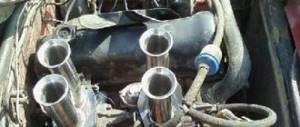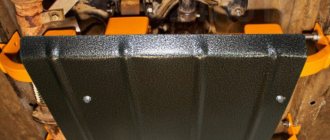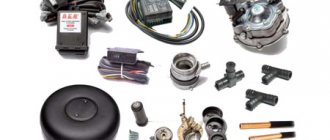Design and principle of operation of a wood-burning gas generator
You can get flammable gas by burning wood in a gas generator
Under normal conditions, with free access to oxygen, the process of burning wood is accompanied by the release of a certain amount of heat. But when there is not enough oxygen for active combustion, firewood smolders to form wood gas, which includes flammable gases CO (carbon monoxide), H2 (hydrogen), CH4 (methane) and unsaturated hydrocarbons without tar. Also, non-flammable substances are formed at the outlet: CO2, O2, N2, H2O, which are ballast; ultimately, the gas mixture must be purified from them.
The gas generator is designed as follows:
- The body is made of steel, most often cylindrical in shape. There is a filling chamber into which fuel is loaded. The camera is installed inside the housing and secured with bolts. The loading chamber hatch is equipped with a seal.
- The combustion chamber is installed in the lower part; the inside is ceramic. Fuel burns in it. Resin cracking occurs in its lower part - there is a chromium steel neck with an asbestos cord, which acts as a sealing gasket between it and the body.
- Air is supplied to the combustion chamber through openings connected to the air distribution box, the so-called tuyeres. A check valve is installed at the outlet of the chamber to prevent the escape of flammable gas. A fan installed at the inlet allows you to increase engine power or burn fuel with a humidity of more than 50% in a wood-burning gas generator.
- The grate is located at the bottom of the gas generator and is designed to hold hot coals. It has holes through which the ash falls into the ash pan. Its middle part is movable so that it can be cleaned.
- There are several loading hatches: the top one with a shock absorber that lifts the lid when there is excess pressure, and two side hatches: one higher for adding fuel to the recovery zone, and the other lower for removing ash.
- A cyclone vortex type filter is located behind the housing. Here, rough gas purification is carried out. Then the gas mixture is cooled in a cooler and enters a fine filter. After the filter, it is sent to the mixer, where it is saturated with air. Then the gas-air mixture is delivered to the place of use.
The pipeline through which the gas is transported to the place of direct use is most often connected to a pipe installed in the recovery zone. While the gas is hot at the outlet of the gas generator, it can be used to heat water and dry firewood in the loading chamber. For example, in the latter case, a pipe is passed between the gas generator housing and the filling hopper.
Homemade gas generator device
The combustible gas in the gas generator is obtained as follows:
- At the top of the loading chamber the temperature is 150–200°C. Due to the fact that a ring pipeline is organized through which hot gas, just released from the gas generator, passes, the firewood is dried here.
- The middle part of the bunker is the dry distillation zone. At this level, the fuel is charred at a temperature of 300–500°C without access to air. Tar and acids are released from the fuel.
- In the combustion zone, which is located below the combustion chamber, the temperature is maintained at 1100–1300°C. The charred fuel, as well as the tars and acids released from it, burn due to the air supply to form CO and CO2 gases.
- The recovery zone is located above the combustion zone: between it and the grate. The CO2 gas that is formed in the combustion zone rises up, overcomes the hot coal and reacts with the carbon in the coal, thereby being reduced to form carbon monoxide. In addition to CO, CO2 and H2 are also formed.
At the exit from the reduction zone, the mixture of gases is cooled, then purified from acetic and formic acid, ash particles and mixed with air.
Design and manufacture of a gas generator
Let's take a closer look at the device of the gas generator. In addition to the housing, inside which the main part of the elements is located, the design includes
:
- bunker (chamber for loading fuel);
- combustion chamber (this is where the wood smoldering process occurs at high temperatures and with minimal air supply);
- the neck of the combustion chamber (resin cracking occurs here);
- an air distribution box equipped with a check valve;
- tuyeres (calibration holes through which the distribution box communicates with the middle part of the combustion chamber);
- grate (serves as a support for smoldering fuel);
- loading hatches equipped with sealed covers (hatches in the upper part are required for loading fuel, in the lower part - for cleaning the unit from accumulated ash);
- outlet pipe (flammable gas escapes through it and enters the welded gas pipeline pipe);
- air cooler (in the form of a coil);
- filters for purifying gas mixtures from unnecessary impurities.
The gas generator circuit may include a fuel drying system. For pyrolysis to be effective, the firewood must be dry. If part of the gas pipeline runs in a ring around the fuel loading chamber (in the space between the walls of this chamber and the housing), the raw firewood will have time to dry before entering the combustion chamber. This will significantly increase the efficiency of the installation.
The body of the gas generator is made of a metal barrel, on top of which a pipe is attached with corners and bolts to a seal, and a propane cylinder is attached to the inside with bolts
Before making a gas generator, you need to find information about a suitable device model and detailed drawings indicating the dimensions of all elements.
Particular attention is paid to the choice of materials for each of the structural elements. The gas generator can have a rectangular or cylindrical shape - the body is usually welded from sheet metal or a metal barrel is used. The bottom and lid must be made of steel sheet with a thickness of 5 mm.
The hopper, which is bolted inside the housing, should be made of mild steel. The combustion chamber is made of heat-resistant steel; you can use an empty liquefied propane cylinder.
The gas cylinder is installed inside the barrel and bolted to its top
Note! If you are going to cut an empty gas cylinder, first fill it to the top with water - this will eliminate the risk of gas vapor exploding if a spark hits it.
The hopper lid should be equipped with a reliable seal made of heat-resistant material (asbestos cord with graphite lubricant). A fire-resistant insulator (asbestos cord or material with similar properties) is laid between the neck of the combustion chamber and the body. It is more convenient to make the metal grate of the grate removable, from reinforcing bars, to make it more convenient to clean the combustion chamber.
The pipe is attached to the bolts on top of the barrel
An air distribution box with a check valve at the outlet is installed outside the housing; a fan can be mounted in front of it to pump air to increase the efficiency of the unit when working on freshly cut wood.
Blower fan to help improve efficiency
Some craftsmen use a steel or bimetallic radiator as an air cooling coil. The mixer, through which purified flammable gas is mixed with air, is equipped with a fan.
When selecting materials for a permanent installation intended to generate electricity for home use, the emphasis is on reliability and affordability. If you need to make a gas generator for a car, preference should be given to stainless steel - this will make the unit lighter and more compact. But the use of stainless steel significantly increases the cost of the design.
Conclusion
The compact wood-burning gas generator is suitable for installation on a truck or car. The unit for a local power plant can be installed in the basement of a house, in an outbuilding, or, if necessary, installed on the street or under a canopy (when it is necessary to provide electricity to any stationary electrical equipment).
The fundamental issue is the correct operation of the gas generator. In order for the unit to operate with high efficiency, it is necessary to carefully adjust the level of air supply (taking into account the moisture content of the fuel), the intensity of gas removal, etc. It is advisable to manufacture a gas generator according to professional drawings, observing all dimensions and proportions.
Video on the topic:
Types of gas generators
Reverse process gas generator
There are gas generators of direct, reverse and horizontal process. In gas generators with a direct type of gas generation, air is supplied from below through a grate, and gas is taken from above. This gas generator is optimally suited for burning semi-coke and anthracite coal. The power of the generator is increased by enriching the gas with hydrogen from water.
The reverse process gas generator differs in that air is supplied to the combustion zone, in the middle part, and gas is taken from the ash pan, below the combustion zone. In such a gas generator, gas is usually used to heat firewood. The device is optimally suited for burning fuels containing resins: wood waste, firewood, charcoal.
In horizontal process gas generators, air is supplied from the side, at the bottom, and a fan is installed at the outlet of the air intake chamber to pump air. The active zone occupies a small space - between the tuyere opening and the gas outlet grid. Such a generator quickly heats up and responds to changes in operating modes.
The pyrolysis boiler has an improved design compared to a simple gas generator. It has two combustion chambers: in the first of them the fuel burns and a combustible gas is formed, and in the other the gas burns and heat is transferred to the coolant. To turn the gas generator into a pyrolysis boiler, you need to add another combustion chamber and a heat exchanger.
Pyrolysis generators completely burn wood, so they are more economical and environmentally friendly
The operating diagram of a pyrolysis gas generator is as follows:
- Air is supplied to the combustion chamber through the adjustable primary air intake chamber window until the wood is ignited.
- Oxygen supply decreases. The boiler switches to gas generation mode, the firewood begins to slowly smolder. This is achieved using an automatic regulator, which reduces the access of air into the firebox.
- As a result, pyrolysis gas begins to be released. It enters the afterburning chamber.
- When the boiler switches to gas generation mode, secondary air is supplied, which is necessary for afterburning. While the air reaches the desired chamber, it is heated to a temperature at which it reacts with the pyrolysis gas.
- The upper chamber contains air distributors with holes. Secondary air enters through them, igniting the fuel gases. Thanks to this, pyrolysis gases are converted into thermal energy.
Emissions of hazardous oxides into the atmosphere are minimal, the temperature of gases from firewood leaving the pyrolysis gas generator does not exceed 130-160°C. The coolant travels from the bottom to the top of the boiler, taking thermal energy from all surfaces.
We collect additional equipment for gasgen
At the stage of assembling the gas generator column, we have already installed an air supply pipe to the combustion chamber. Through another hole on the opposite side of the barrel, the gas mixture will go directly to the coarse filter. We adapt our fire extinguisher for this purpose. We weld the outlet pipe in the upper part, and weld the supply pipe in the lower part so that the mixture gets a swirl and rises in a spiral to the outlet. This is our cyclone type coarse filter.
Coarse filter
After leaving the cyclone, the gas mixture must pass through the radiator and cool significantly. Remember, a drain plug must be installed at the lowest point of the radiator. It’s better to think about this right away, so as not to disturb the assembled structure later or scratch your knees from an uncomfortable position.
More on the topic: The fate of wood-burning cars
Any container filled with slag, mineral wool, straw, etc. is suitable for a fine filter. The main thing is that they are not bulky and have an aesthetic appearance. Don’t forget about the drain plug or condensate drain valve. Now your gas generator is combined with cleaning and cooling systems. You can install it in a prepared place.
Gas generator on Ford
Connecting and starting a wood-burning gas generator
When installing a gas generator on a car, it will be more difficult to start the car - this is better done on gasoline
It is necessary to take into account the peculiarities of using a wood-burning gas generator when connecting it to a car. Experts do not advise completely abandoning gasoline, because starting an engine with wood is problematic. It is recommended to start the engine by supplying gasoline, and only then switch to gas. Switching to different types of fuel can be organized using a mixer made according to I.S. Mezin’s scheme.
There are other restrictions:
- The size of the firewood is no more than 6 cm.
- Only dried wood is used as fuel, because the process of evaporation of water requires additional heat, and in this case less pyrolysis gases are formed.
- A gas generator engine running on wood loses 50% in power compared to a gasoline engine.
- Ignition is carried out with the fan on 20 minutes before departure.
When running on homemade fuel, the engine wears out faster.
Design features of the equipment
What is included in the package of a car gas generator? First of all, it is a device in which the process of converting wood or other fuel into combustible gas occurs. But since the resulting mixture needs to be cleaned, not a single generator for a car can do without cleaners.
Moreover, they are presented in the form of three horizontal structures and one vertical. In the first, preliminary cleaning from mechanical impurities occurs with simultaneous cooling. The vertical cleaner is designed for finer cleaning.
Wood-burning unit diagram
In addition, the wood-burning automobile gas generator includes:
- Condensate settling tank;
- Mixer;
- Fan;
- Pipelines.
As for the design of the gas generator for a car and its main unit, it is enclosed in a housing and consists of a hopper and a fuel compartment. This unit is attached to the car frame.
At the top there is a flange that connects all the parts into one. The loading hatch is equipped with a lid that is pressed with a locking handle. Gas is taken from the pipe. Fuel is loaded through a special hatch. Leaving the unit, the gas is purified sequentially in each cylinder and from there enters the engine.
Advantages and disadvantages of gasgen
Gas generators can be used in an autonomous gasification scheme at home
One of the advantages of a gas generator installation is the wide range of possibilities for using combustible gas:
- for cooking food;
- for heating a house;
- as fuel for internal combustion engines.
In the first case, pipes from the gas generator are connected to the kitchen stove. In the second, the resulting gas is burned in a pyrolysis boiler and used for heating residential buildings, greenhouses, as well as industrial premises, workshops and enterprises. Internal combustion engines running on gas drive electric generators, pumping stations and even cars.
In addition, there are other positive aspects:
- Some models of wood-burning gas generators are autonomous. They can be installed where it is impossible to install electricity or where it is difficult to supply gas in cylinders.
- Compared to a solid fuel boiler, whose efficiency is about 60%, a gas generator boiler operates with an efficiency of 80–95%.
- In a regular boiler, wood burns out in 3–5 hours. In a gas generator, one fill burns out in about 8–12 hours, and the burning rate depends on the type of fuel and the design of the boiler. If the boiler is top-burning, wood burns for up to 25 hours, and coal for 5–8 days.
- Wood fuel burns completely, so there is no need to frequently clean the flue and ash pan.
- The power of the gas generator is adjustable from 30 to 100%.
- The gas generator practically does not emit harmful substances into the atmosphere.
- The installations are economical compared to conventional gas or liquid fuel boilers.
- Some gas generators can cope with partially dried wood and even freshly cut wood.
- It is not necessary to chop logs; firewood up to 1 meter long can be placed in the gasgen.
- You can load polymer materials into the sawdust and wood gas generator: rubber, polyethylene, plastic.
- The gas generator is safer when compared with a solid fuel boiler.
The gas generator costs more than the price of a solid fuel boiler
Flaws:
- A gas generator costs about 2 times more than a conventional solid fuel boiler.
- Not all models can work without electricity; some devices use a fan to pump air, which requires connection to an electrical outlet.
- The consequence of using at partial power is unstable combustion, which leads to the formation of tar.
- Low heating return temperature (below 60°C) causes condensation to form.
- Some models only work on well-dried wood.
Considering the cost of consumables, even a self-made wood-burning gas generator will be quite expensive.
Making a gas generator with your own hands
You can draw up a diagram of the gas generator yourself, having studied the principle of its operation, or use a drawing of a finished boiler as a basis and assemble its analogue. Craftsmen even independently assemble gas generators designed to generate electricity using wood.
To make a wood-burning gas generator for a motorcycle with your own hands you will need:
- 100-liter metal barrel;
- thick-walled pipe with a diameter of 160 mm;
- filters for fine and coarse cleaning;
- stainless steel kettle;
- mower disc;
- hexagon;
- low temperature battery;
- pipe with squeegee;
- fire extinguisher;
- metal can;
- receiver.
Scheme of a gas generator installation for DIY production
Holes are drilled in the pipe to install tuyeres. A hole is made in the disc from the rotary mower to match the diameter of the pipe. The disk and pipe are welded together. A can is welded on top, as well as pipes for air supply and gas exhaust.
A fire extinguisher is needed to make a centrifugal type cleaner. Two pipes are welded to it - on top and on the side, and the fire extinguisher itself is welded to a barrel that does not have a lid or bottom. In the barrel, in the lower part, a hole is cut to collect ash and closed with a screw plug.
A welded structure of a pipe and a can is installed in a barrel. The supports are first welded to the disk and an ash pan made from a kettle is hung on chains from below. A barrel lid with a hole pre-cut in it is installed on the can.
A cooler is constructed from a low-temperature battery and connected to the finished structure using flanges. Be sure to make a hole to drain condensate.
The filter is made from two metal paint buckets. They are placed on top of each other and welded. Holes are made in the bottom. The upper one is filled with mineral wool, and the lower one with expanded clay.
A fan for ignition can be made from a tractor stove. It is installed in the front area of a motorcycle sidecar with a subframe and connected to the system using polymer pipes. Two ball valves are installed as gas flow regulators: one to the ignition fan, the other to the mixer. The mixer is located in front of the carburetor and connected to the distributor. A manifold made of steel pipes is constructed under the carburetor.
The hopper for solid fuel is fixed inside the housing or a part of the gasgen housing is allocated for this purpose, separating it with metal sheets.
It is worth welding legs to the bottom of the barrel, which will ensure the stability of the structure.
It is necessary to carefully seal the gasgen assembled with your own hands, because the absence of uncontrolled access to oxygen is the main condition for the correct operation of the device.
How to make a wood-burning gas generator for heating a house with your own hands
Before you start making a gas generator with your own hands, you need to take a closer look at its design and understand the principles of operation.
Layout of elements and outline of the unit
The unit must consist of:
- the housing in which the remaining elements are enclosed;
- a bunker, also called a filling chamber, into which fuel is loaded;
- combustion chamber, in which the fuel combustion process occurs at very high temperatures;
- the neck of the combustion chamber, where the cracking of resins takes place;
- air distribution box with check valve;
- calibration holes, called tuyeres, which connect the middle part of the combustion chamber to the distribution box;
- grate designed to support coals;
- loading hatches with sealed covers (top and side - for loading fuel, bottom - for removing ash);
- a gas outlet pipe to which gas pipeline pipes are welded;
- a cooler, passing through which the gas cools to the required temperature;
- filters for purifying gas from impurities.
The diagram below shows how the elements of the gas generator are placed.
This diagram clearly shows all the components of the unit
The hot gas produced in the generator can be used to dry the fuel. To do this, part of the gas pipeline must be routed in a ring around the combustion chamber, placing it between the device body and the fuel loading chamber. This allows you to increase the efficiency of the device. A drawing of the device is shown below.
With a drawing it will be much easier to assemble the structure
Since the operation of a homemade sawdust generator occurs at high temperatures, fairly stringent requirements are imposed on each structural element. The body is usually welded from sheet metal, with small metal legs attached to the bottom. Traditionally it is made in a cylindrical shape, but there is no rule that says it cannot have a rectangular configuration.
This diagram clearly shows the design features of a wood-burning gas generator. Leaving the combustion chamber, the gases are mixed with air, cooled, and then undergo final purification
Stages of work on assembling a steel unit
Low carbon steel should be used to make the hopper. It is installed inside the housing and secured with bolts. The hopper lid needs a seal. Asbestos is often used for this, but it is considered hazardous to health, so you should purchase gaskets made from another heat-resistant material.
A combustion chamber made of heat-resistant steel is installed in the lower part of the bunker, and a neck is attached to the chamber. The body is separated from the neck with a sealing asbestos cord or other insulator.
Craftsmen who have managed to make a homemade gas generator note that it is convenient to use a gas cylinder, new or used, as a combustion chamber. In the latter case, there is a danger of the remaining gas igniting when the top of the cylinder is cut off. To prevent this from happening, the gas cylinder should be filled with water and then begin work.
The air distribution box is installed outside the gas generator housing. In order for a self-made wood-burning gas generator to work properly, a check valve should be installed at the outlet of the box to prevent gas from leaving the device through this hole. You can place a fan in front of the box to pump air. This design allows you to use even freshly cut wood for combustion, the humidity of which exceeds 50% (the norm for solid fuel boilers is 20%)
You can make a wood-burning gas generator from various suitable materials, for example, from a metal barrel or an old gas cylinder
The grate is most often made of cast iron. To simplify the cleaning procedure, the middle part of the grate is made movable, controlled by a special lever. An important element of the loading hatch is a shock-absorbing spring, which will allow you to lift the hatch cover in the event of excessive gas accumulation in the bunker.
Homemade gas generator from a cylinder or barrel
The barrel acts as a combustion chamber
Any barrel is suitable for making a boiler; you can even use an empty gas cylinder or make it yourself using welding and a sheet of steel. The thickness of the sheet should, as a rule, be no more than ten millimeters. You will need rings that will serve as a coarse gas filter and pipes that will serve as cold air intakes. It is also necessary to consider the removal of condensate so that it does not accumulate at the bottom of the boiler. This problem is most often solved by installing a drain valve.
Gas generators made at the factory cost a lot. Therefore, not everyone can afford them. Craftsmen prefer to make boilers themselves by following these steps:
- Weld a cylinder from a sheet of steel and attach the legs. The body is ready.
- Make a hopper and secure it to the top of the boiler with bolts. For the manufacture of this component, less carbon steel can be used.
- Make a combustion chamber from a gas cylinder.
Before cutting the cylinder, fill it with water, as residual gas may accumulate on top.
Small wood-burning gas generators can be installed in the house, since there is no risk of debris accumulating when loading, and the fuel can be stored next to the boiler.
Large units should be installed outdoors as close as possible to the storage area of natural fuel material. In such a situation, it is possible to transport firewood to the device without much inconvenience. In addition, when placing the boiler in the yard, it will be possible to avoid contamination of the room with ash and dirt.
If the gas generator is located on the street, then for ease of connecting it, the pipes to the heating boiler should be laid on the ground.











